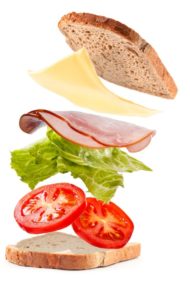Each year we celebrate the sandwich; to be exact, November 3, 2017 is National Sandwich Day. The sandwich was popularized in the 1700s by the 4th Earl of Sandwich, (Sandwich is a medieval town in southeast England in the county of Kent.) The legend goes that the Earl asked for a hunk of beef between two slices of bread so he could hold the meal in one hand while he played cards. One of his companions is to have said, “I’ll have the same as Sandwich,” as thus the humble and delicious sandwich was born.1
What makes a truly great sandwich? The overwhelming response to that question is bread, with 42% of people saying the bread is most important ingredient in a sandwich.2 Yet, many people give up bread thinking it contributes to excess calories. In a recent study3, researchers found that all grain foods, including breads, contributed less than 15% of all calories in the total diet, while delivering nutrients that are in short supply in the diet of many Americans including dietary fiber, folate, iron, calcium, magnesium, and vitamin A.

In a new study,4 researchers sought to model a better sandwich. They wanted to know how children and adolescents could enjoy sandwiches by altering the fillings to reduce calories, fat, and sodium without giving up the bread they love. By studying over 9,000 sandwich-eaters from the dataset, What We Eat in America, researchers took a statistical modeling approach and removed all the energy (calories) and nutrients from the usual sandwiches and substituted four different sandwiches:
- 2 slices of whole grain bread, 2-3 slices of lunch meat, 1 slice of cheese with a few leaves of dark greens and a slice of tomato
- 2 slices of whole grain bread with 2 Tablespoons of peanut butter and 1 Tablespoon of jam
- Or, the same combinations substituting enriched, refined grain bread for the whole grain bread.
By making these substitutions, calories were reduced from 46 to 87 calories a day, while total fat was reduced by 5 to 14 grams a day. Saturated fat was reduced to about 5 grams a day. Sodium was reduced from 400 to 790 mg a day compared to the typical food pattern consumed by children and adolescents. The sodium reduction is equal to removing a fast food cheeseburger and small order of French fries5 from a child’s diet.
The study also showed that using either whole grain or enriched refined grains led to reducing calories while increasing nutrients, such as the B-vitamin folate and the minerals iron, calcium, and magnesium. These nutrients are needed by children and adolescents to support bone health and make new red blood cells. Anemia, a common childhood disorder, can be caused by lack of dietary iron during critical growth phases, especially as boys and girls go through puberty5.
The bottom line message of this study is that it is the ingredients between the slices of bread that should be the focus of delivering a healthier sandwich. All grains, both whole and enriched, are nutrient-rich and provide several important nutrients needed by children. With so many delicious breads to select from, choose your favorite and be mindful of the filling. Know your stuff before you cut, and modify the sandwich portions and filling, not the best part…the bread!
1Sandwich celebrates 250th anniversary of the sandwich. British Broadcasting System; May 12, 2012. http://www.bbc.com/news/uk-england-kent-18010424
2The Keynote Report on Sandwiches. Datassential. September 2014. https://datassential.com/Pdf/MenuTrends%20Sandwich%20Keynote.pdf
3Papanikolaou Y & Fulgoni VL. Grain foods are meaningful contributors of nutrient density of American adults and help close nutrient recommendation gaps: Data from the National Health and Nutrition Examination Survey, 2009-2012. Nutrients. 2017: Aug 14;9(8). pii: E873. doi: 10.3390/nu9080873
4Papanikolaou Y & Fulgoni VL. Certain Grain Foods Can Be Meaningful Contributors to Nutrient Density in the Diets of U.S. Children and Adolescents: Data from the National Health and Nutrition Examination Survey, 2009–2012. Nutrients 2017, 9(2), 160; doi:10.3390/nu9020160
5McDonald’s cheeseburger has 700 mg sodium and a small fries has 180 mg sodium.
6Anemia caused by low iron. Medline Plus. https://medlineplus.gov/ency/article/007134.htm

